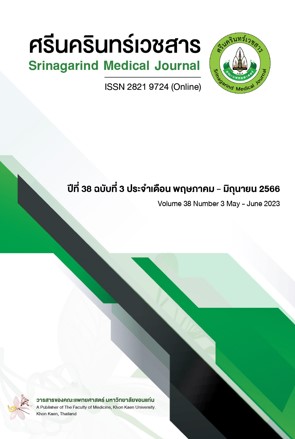The Effects of Diosmin on Kidney Morphology and Functions in Renovascular Hypertensive Rats
Keywords:
Diosmin, renovascular hypertension, kidney morphology, kidney functionAbstract
Background and objective: Renovascular hypertension associated with vascular and kidney dysfunctions have been reported. The possible mechanism might be related to oxidative stress. Diosmin is a flavonoid that is abundant in the Rutaceae family. It exerts numerous biological activities such as anti-oxidation and antihypertension. However, the study of diosmin in renovascular hypertension is still unexplored. Thus, the purpose of this study was to investigate the effects of diosmin on kidney morphology and function in two-kidney, one-clip (2K-1C) hypertension.
Method: Male Sprague-Dawley rats (150-160g) were used in this study. The left renal artery was clipped with a silver clip to induce hypertension. Three weeks after the operation, the rats were divided into five groups (n=5/each) including sham rats treated with vehicle (1.5 ml/kg/day); 2K-1C rats treated with vehicle (1.5 ml/kg/day); 2K-1C rats treated with diosmin (50 and 100 mg/kg/day); and 2K-1C rats treated with telmisartan (5 mg/kg/day) for four weeks by oral gavage. Systolic blood pressure (SP) was measured weekly using the tail-cuff method. At the end of the experiment, the urine sample and the kidney of all rats were collected for biochemical and morphological studies.
Results: Treatment with diosmin (100 mg/kg/day) significantly reduced high blood pressure in 2K-1C hypertensive rats (p < 0.05). Increases in kidney tissue malondialdehyde (MDA) and superoxide productions in 2K-1C rats were ameliorated by diosmin (100 mg/kg/day) (p < 0.05). It also improved kidney function via the elevation of creatinine (Cr) and blood urine nitrogen (BUN) in urine compared with untreated 2K-1C group (p < 0.05). Moreover, improved kidney morphology via reduced glomerular cross-sectional area (CAS), glomerular tuft area, Bowman's space area, and glomerular volume in the non-clipped kidney (p < 0.05). In addition, treatment with telmisartan had a similar effect to diosmin (100 mg/kg/day).
Conclusion: Diosmin exerts an antihypertensive effect in renovascular hypertensive rats. It also improved kidney morphology and functions in 2K-1C rats. This effect might be relevant to its antioxidative effect.
References
Elliott WJ. Systemic hypertension. Curr Probl Cardiol. 2007;32:201-59. doi.org/10.1016/j.cpcardiol.2007.01.002
Hong MH, Jin XJ, Yoon JJ, Lee YJ, Oh HC, Lee HS et al. Antihypertensive Effects of Gynura divaricata (L.) DC in Rats with Renovascular Hypertension. Nutrients 2020;12(11):3321. doi.org/10.3390/nu12113321
Mamun F, Rahman MM, Zamila M, Subhan N, Hossain H, Raquibul Hasan SM, et al. Polyphenolic compounds of litchi leaf augment kidney and heart functions in 2K1C rats. J Functional Foodsd 2020;64:103662. doi.org/10.1016/j.jff.2019.103662.
Fink GD. Long-term sympatho-excitatory effect of angiotensin II: a mechanism of spontaneous and renovascular hypertension. Clin Exp Pharmacol Physiol 1997;24:91-95. doi.org/10.1111/j.1440-1681.1997.tb01789.x
Chaihongsa N, Maneesai P, Sangartit W, Rattanakanokchai S, Potue P, Khamseekaew J et al. Cardiorenal dysfunction and hypertrophy induced by renal artery occlusion are normalized by galangin treatment in rats. Biomed Pharmacother 2022;152:113231. doi.org/10.1016/j.biopha.2022.113231.
Jha JC, Banal C, Chow BS, Cooper ME, Jandeleit-Dahm K. Diabetes and kidney disease: role of oxidative stress. Antioxid Redox Signal 2016;25:657-84. doi.org/ 10.1089/ars.2016.6664.
Iampanichakul M, Poasakate A, Potue P, Rattanakanokchai S, Maneesai P, Prachaney P, et al. Nobiletin resolves left ventricular and renal changes in 2K-1C hypertensive rats. Sci Rep 2022;12(1):9289. doi.org/10.1038/s41598-022-13513-6.
Poasakate A, Maneesai P, Potue P, Bunbupha S, Tong-un T, Ishida W et al. Genistein alleviates renin-angiotensin system mediated vascular and kidney alterations in renovascular hypertensive rats. Biomed Pharmacother 2022;146:112601. doi.org/10.1016/j.biopha.2021.112601.
Gerges SH, Wahdan SA, Elsherbiny DA, El-Demerdash E. Pharmacology of diosmin, a citrus flavone glycoside: an updated review. Eur J Drug Metab Pharmacokinet 2022;47:1-18. doi.org/10.1007/s13318-021-00731-y.
Huwait E, Mobashir M. Potential and therapeutic roles of diosmin in human diseases. Biomedicines 2022;10(5):1076. doi.org/10.3390/biomedicines10051076.
Srinivasan S, Pari L. Ameliorative effect of diosmin, a citrus flavonoid against streptozotocin-nicotinamide generated oxidative stress induced diabetic rats. Chem Biol Interact 2012;195(1):43-51. doi.org/10.1016/j.cbi.2011.10.003.
Tekeli MY, Eraslan G, Çakır Bayram L, Soyer Sarıca Z. Effect of diosmin on lipid peoxidation and organ damage against subacute deltamethrin exposure in rats. Environ Sci Pollut Res Int 2021;28:15890-908. doi.org/10.1007/s11356-020-11277-y.
Silambarasan T, Raja B. Diosmin, a bioflavonoid reverses alterations in blood pressure, nitric oxide, lipid peroxides and antioxidant status in DOCA-salt induced hypertensive rats. Eur J Pharmacol 2012;679: 81-9. doi.org/10.1016/j.ejphar.2011.12.040.
Singh S, Kushwaha BP, Nag SK, Mishra AK, Singh A, Anele UY. In vitro ruminal fermentation, protein and carbohydrate fractionation, methane production and prediction of twelve commonly used Indian green forages. Animal Feed Science and Technology 2012;178:2-11. doi.org/10.1016/j.anifeedsci.2012.08.019.
Kukongviriyapan U, Luangaram S, Leekhaosoong K, Kukongviriyapan V, Preeprame S. Antioxidant and vascular protective activities of Cratoxylum formosum, Syzygium gratum and Limnophila aromatica. Biol Pharm Bull 2007;30:661-6. doi.org/10.1248/bpb.30.661.
Lu FJ, Lin JT, Wang HP, Huang WC. A simple, sensitive, non-stimulated photon counting system for detection of superoxide anion in whole blood. Experientia 1996;52:141-4. doi.org/10.1007/bf01923359.
Nakmareong S, Kukongviriyapan U, Pakdeechote P, Donpunha W, Kukongviriyapan V, Kongyingyoes B et al. Antioxidant and vascular protective effects of curcumin and tetrahydrocurcumin in rats with L-NAME-induced hypertension. Naunyn Schmiedebergs Arch Pharmacol 2011;383:519-29. doi.org/10.1007/s00210-011-0624-z.
Campos RR, Oliveira-Sales EB, Nishi EE, Paton JF, Bergamaschi CT. Mechanisms of renal sympathetic activation in renovascular hypertension. Exp Physiol 2015;100:496-501. doi.org/10.1113/expphysiol.2014.079855.
Uddin MJ, Kim EH, Hannan MA, Ha H. Pharmacotherapy against oxidative stress in chronic kidney disease: promising small molecule natural products targeting Nrf2-HO-1 signaling. Antioxidants (Basel) 2021;10(2):258. doi.org/10.3390/antiox10020258
López-Novoa JM, Rodríguez-Peña AB, Ortiz A, Martínez-Salgado C, López Hernández FJ. Etiopathology of chronic tubular, glomerular and renovascular nephropathies: clinical implications. J Transl Med 2011;9:13. doi.org/10.1186/1479-5876-9-13
Downloads
Published
How to Cite
Issue
Section
License
Copyright (c) 2023 Srinagarind Medical Journal

This work is licensed under a Creative Commons Attribution-NonCommercial-NoDerivatives 4.0 International License.




